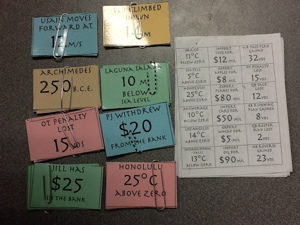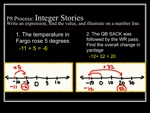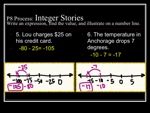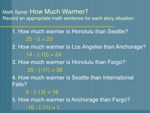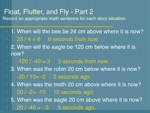New Blogger Initiative: Integer Context Cards
For Week 2 of the “New Math Blogger Initiative” (or is it an “initiation?” hmmmmm) I decided to learn how to embed a document using Scribd and show something that I am proud to share!
If you read my Made4Math post from last week (Math Cards) you know I like “multi-purpose” tools. I haven’t been teaching Middle School too long, in the grand scheme of things, and when I first had the opportunity to introduce Integers to a class of very low sixth graders (all Level 1 on the state test) I knew that putting them into context would make all the difference. So. . . what are some contexts for integers? Well, there’s temperature, and altitude, and money. . .? I brainstormed long and hard and came up with quite a list.
Without further ado, my very first Scribd document!
Integer Context Cards
(Hmmmm. Rats! The font changed when I uploaded the document. The original was in Herculanum, a very cool looking ALL CAPS font, so now it appears that I don’t know my capitalization rules – oh well.)
There are a total of eighteen different contexts with six cards for each one. Some are “stretching it” a bit, but still reasonable. Note: for altitude, one of the cards is for Arlington, Washington where my school is located, so you might want to “personalize” that one. 🙂
I made one copy of each page on a different color of copy paper to make them easier to sort and then had them laminated, cut, and paperclipped in sets of six. (I only made one set for the entire class, but you can certainly create duplicates, especially if you have a very large class.)
Order, Order, Order
Phase 1: After a brief exposure to a few of the cards, we started our first activity with the cards. My students were already assigned to groups of six. We actually went out into a space in the hall for this.) Each group received a different set of cards, passed them out amongst the group members, and silently “raced” to put themselves in order from least to greatest. Once a group was done, they ALL had to raise their hands. After I checked for accuracy, they turned in their set and grabbed a new one. (The first year I did this I checked the groups off on a master sheet, but the following years I just trusted their memory – “We already did that set.”) The goal was to accurately get through as many sets as they could in the time allotted. Often enough, groups were in too much of a hurry to read carefully enough to identify the “key words” that signified whether their value was positive or negative. Getting a “no” when their hands were raised definitely encouraged them to take their time a bit more.
Phase 2: The next activity took it just a bit further. Groups (of three this time) had a sheet of number lines. Each time they received a new set of cards they had to “fairly accurately” plot and label all six values (along with zero if it wasn’t in the set) on a number line. Choosing a scale was challenging for some of the sets (especially with the first group of students.)
(See the cool font? Oh, well.)
Integer Operations in Context
A few weeks later in the year, my seventh grade class was working on operations with integers. I printed the Integer Card sheets four to a page and created little packets for students to share. (See the image above.) Using a “Think Pair Share” type of model, I posed questions using the people, places, or things on the cards and students had to write a math sentence, model the problem on a number line, and find the value (first on their own paper, then with a partner on a mini-whiteboard.) A big key was writing the math sentence as opposed to just finding the value. I wanted them to make the connection so that when they saw a “naked numbers” problem they could try to connect it to the contexts we worked with in class.
We initially focused on addition and subtraction situations:
(**The white text is shown first. After the Think-Pair-Share on whiteboards I reveal the number sentence and diagram and move onto the next problem.**)
Next we moved onto subtraction in “finding differences” contexts, as well as multiplication and division. I dropped the “number line” requirement, although we did end up sharing it on some of the more challenging multiplication/division situations. (Again, the white text for each problem is given first, TPS, then the yellow answer is revealed, discussed, and we move on to the next problem.)
In subsequent years I used the Integer Operation activities with my sixth grade classes as we introduced this seventh grade concept in the Spring after the state test. During “Review Activities” time in class I had small groups create original “stories” along with their associated number sentences, from the cards, but I think I would like to make that a more integral part of the initial learning as well.
Ahhhhh, context! Even if it is really “pseudo context,” in this situation students have something to grab onto that helps them make sense of the integer operations as opposed to a mercurial “set of rules to follow.” On the other hand, it is THROUGH these experiences that students begin to create their OWN rules about the patterns involved in integer operations, but only when the concepts “make sense” to THEM! I think we are finding a bit of EMU right there. 🙂
Note: There are multiple slides for each operation, and if I got my act together I might copy and paste them all into one slide show and try to attach them, but that would take a higher level of understanding on Scribd than I currently possess, as the slides are all now on my iPad, and I am just sharing screenshots.
